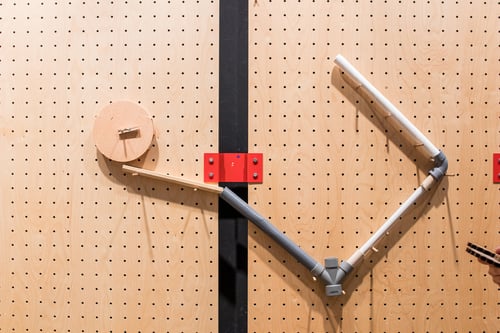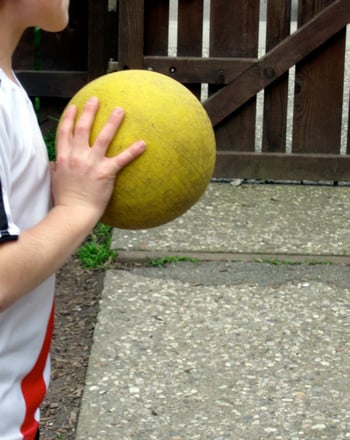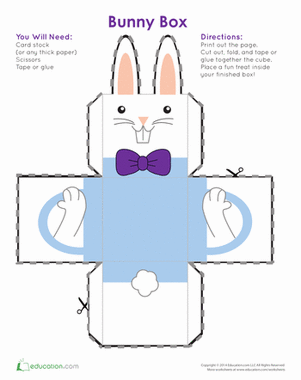Activity
Design Challenge: Egg Drop
In this challenge, your child’s task is to create a device that will protect an egg when it is dropped from a height of about 10 feet. Since this prompt is open-ended, your child can be creative with how they make their egg drop device. This activity doesn’t require a specific set of materials, so feel free to give your child any arts and crafts materials you have around the house and allow them to decide how to use them. This activity is aligned to the following NGSS: 3-5-ETS1-1, 3-5-ETS1-2, 3-5-ETS1-3.
Grade
Subject
Thank you for your input.
What You Need:
- At least one egg (exact number depends on how many tests you complete)
- A designated location about 10 feet above the ground from which you’ll drop the egg (i.e. top of play structure, balcony)
- Tape or glue
- Scissors
- A variety of arts and crafts materials that your child could potentially use to construct their device (e.g., cotton balls, rubber bands, straws)
- Pen and paper for brainstorming
What You Do:
- First, fully explain the design challenge to your child. Tell them that their job is to create a device that will protect an egg when it’s dropped from a height of 10 feet. Show them the exact spot from which they will drop the egg.
- Make sure your child understands that this prompt is open-ended. There’s not one "correct" way to make the device. Encourage them to be creative!
- After your child fully understands the challenge, allow them to start brainstorming ideas for the device they want to build. Ask them to write or draw their ideas on a piece of paper.
- Feel free to show your child the materials you’re providing so that they know what they’re working with. However, don’t allow them to start building quite yet.
- Once your child has come up with a few different ideas, ask them to pick the one they think will work best. This will teach your child to prioritize the functionality of their device without getting emotionally attached to their ideas.
- After your child has chosen a design, allow them to start prototyping (building)! Be sure to supervise for safety purposes, but allow them to work independently as much as possible. Allow them to work through challenges to the best of their ability.
- Once your child has built their prototype, it’s time to test it. Go to your designated location for the egg drop, and ask your child to use their device.
- If your child’s prototype is successful, congratulate them for completing this challenge.
- If your child’s prototype doesn’t work, it’s important that they don’t get discouraged. Frame the outcome as an opportunity for your child to learn, and help them come up with ideas as to why their design didn’t work. Then, go back to the beginning of this process and help your child come up with a better design.
Related learning resources

Humpty Dumpty and Design Thinking
Lesson plan
Humpty Dumpty and Design Thinking
Transform the traditional egg drop experiment as you help students to engage in design thinking and develop empathy.
3rd grade
Science
Lesson plan

Design Challenge: Inflate a Balloon
Activity
Design Challenge: Inflate a Balloon
In this exciting design challenge, your child will use design thinking skills to create a mixture that can inflate a balloon.
3rd grade
Science
Activity

Design Challenge: Making a Parachute
Activity
Design Challenge: Making a Parachute
In this design challenge, your child will create a parachute for a small toy using typical household items.
3rd grade
Science
Activity

STEM Design Challenge Cards
Worksheet
STEM Design Challenge Cards
These STEM design challenge cards ask learners to build something new for a specific reason or purpose and are a great way to foster creative thinking.
2nd grade
Science
Worksheet

Design Challenge: Making a Bottle Rocket
Activity
Design Challenge: Making a Bottle Rocket
In this design challenge, your child will make a bottle rocket using typical household items.
3rd grade
Science
Activity

Design Challenge: Make a Rube Goldberg Machine
Activity
Design Challenge: Make a Rube Goldberg Machine
In this hands-on design challenge your child will make their very own Rube Goldberg Machine.
3rd grade
Science
Activity

Design Challenge: Improve the School
Activity
Design Challenge: Improve the School
In this open-ended activity, students will be given a small quantity of three types of materials and asked to design a prototype for “something that will improve the school.”
5th grade
Science
Activity

Play Drop Catch
Activity
Play Drop Catch
Develop your child's hand-eye coordination in a fun and engaging way by challenging her to a game of Drop Catch.
4th grade
Activity

Design and Build a City
Activity
Design and Build a City
Challenge your learner to design and build a city of their own in this creative engineering activity.
3rd grade
Science
Activity

STEM Design Challenge: Brainstorm and Reflection Sheet
Worksheet
STEM Design Challenge: Brainstorm and Reflection Sheet
Help children hone their creativity and critical thinking skills while providing hands-on experience with design planning, reflection, and writing process.
2nd grade
Reading & Writing
Worksheet

Design Challenge: Creating Animal Habitats
Activity
Design Challenge: Creating Animal Habitats
In this design thinking activity, your child will choose an animal to research, learn about the animal’s habitat, and then replicate the animal's habitat using household items.
2nd grade
Reading & Writing
Activity

Easter Egg Holder
Worksheet
Easter Egg Holder
Protect your precious egg hunt plunder with this Easter egg holder craft.
3rd grade
Arts & crafts
Worksheet



